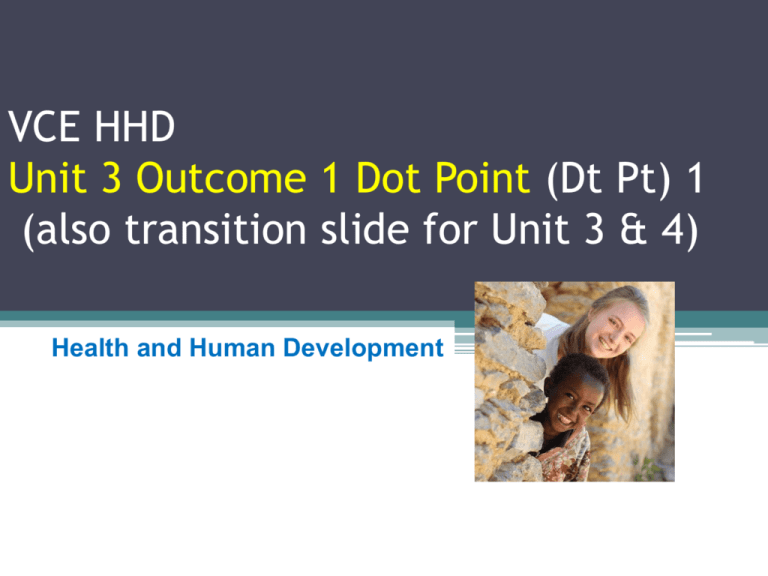Unit 3, Outcome 1 - Health and Human Development Units 3 & 4
advertisement

VCE HHD Unit 3 Outcome 1 Dot Point (Dt Pt) 1 (also transition slide for Unit 3 & 4) Health and Human Development • • • • • • • • • • • The course 2014 Unit 3 – Australia’s Health - 2 Outcomes Unit 4 – Global Health and Human Development- 2 Outcomes Each Unit has 3 SACs Unit 3 OC 1 = 2 SACs (30 marks each = 60) Unit 3 OC 2 = 1 SAC (40 marks) Unit 4 OC 1 = 2 SACs (25 marks each = 50) Unit 4 OC 2 = 1 SAC (50 marks) TOTAL MARKS FOR ALL SACS = 200 SAC marks contribute 50% of final Study Score End of year Examination contributes 50% of final Study Score You should have: - VCAA Study Design (2014-2017) - emailed - Unit 3 VCCA course outline (KK and KS) – hard copy - VCAA Glossary – hard copy KEEP BOTH DOCUMENTS AT FRONT OF FOLDER • Text Book • Other: Unit 3 • Key Knowledge (Dt Pt ) • 3.1.1 (means Unit 3 Outcome 1 Dt Pt 1 !) ▫ Definitions of physical, social and mental dimensions of health and health status • Key Skills ▫ Define key health terms Health • Write down what health means to you, using key words that you associate with the term health. Are these people healthy? How do these images reflect the different dimensions of health? World Health Organisation WHO Definition of health NB not part of U3/4 Study design • A state of complete physical, mental and social wellbeing and not merely the absence of disease or infirmity. • Definition ▫ Limitations ? ▫ Strengths ? WHO definition of Health Strengths: Health is a positive concept - it recognises positive aspects of health (i.e. not merely the absence of disease or infirmity) Involves the whole person (i.e. other dimensions of health - social, mental and not just the physical aspects) Wellbeing - Health is influenced by a wide range of factors/aspects of life Health is dynamic, constantly changing WHO definition of Health Limitations: The word ‘Complete’, which suggests an ideal or perfect state. Most people would agree such a state is not achievable. If not in a complete state in all areas of health at once, you are not healthy according to this definition. Not easily measured – most of the information and measures of health is about ill-health, rather than the positive features described in the WHO definition Wellbeing is subjective and difficult to measure Absence of influence of environmental and inherited factors on health Dimensions of health (P M S) • Physical health is??? • Social health is ??? • Mental health is ??? MUST: 1. LEARN THESE DEFINITIONS 2. BE ABLE TO RECOGNISE / STATE SOME EXAMPLES OF EACH Physical Health p.5-6 text Relates to the efficient functioning of the body and its systems, and includes the physical capacity to perform tasks and physical fitness. (Study Design) Positive aspects / examples include: • The ability to resist disease • Having a high fitness level • The ability to recover from illness and injury • Having sufficient energy, strength and coordination to engage in daily physical activity • Having a healthy body weight • Being free from disease or illness Social Health p.7-8 text Being able to interact with others and participate in the community in both an independent and cooperative way. (SD) Positive aspects / examples include: • Ability to develop and maintain social interactions and relationships with others • Being able to positively and effectively communicate with others • Ability to learn and use appropriate social skills • Making a positive contribution to the community • Accepting responsibility for own actions Mental Health p.8-9 text ‘State of wellbeing in which the individual realises his or her own abilities, can cope with normal stresses of life, and can work productively and fruitfully, and is able to make a contribution to his or her community. (SD) Positive aspects / examples include: • Ability to understand and express emotions • A high level of self confidence • Having a positive /high level of self esteem • The ability to cope with challenging situations • Being able to deal with stress Interrelationships between dimensions of health Health is a changing entity A HEALTH CONTINUUM premature death major symptoms illness ill health average above average optimal health health health • Where on the health continuum would you rate your health at this present time? • Where would it have been 5 years ago? • Has it moved over time? Explain • Where would you expect it to be in 5 years time? • What factors may impact on your health over the next 5 years? How would you rate? Using the ‘Health Continuum’ place the following people on the continuum (discuss with partner): ▫ How would you rate an Australian wheelchair athlete who has a very high levels of physical fitness and ability to cope with stress ? ▫ A woman who has recently recovered from breast cancer , and is now in remission. ▫ A 15 year old girl who has not had a day off from school all year and smokes 3-4 cigarettes a day. ▫ A 17 year old boy who is extremely depressed and withdrawn from friends. ▫ A 90 year old man who walks 4 km a day and whose wife of 60 years just passed away. Health Status p.14-19 text • An individual’s or populations overall level of health, taking into account various aspects such as life expectancy, amount of disability, and levels of disease risk factors (AIHW, 2008)SD • Important data: Life expectancy, information about diseases/illness, comparisons with other countries • Information about the health status of a population helps governments shape health policies and to determine how health services should be delivered









